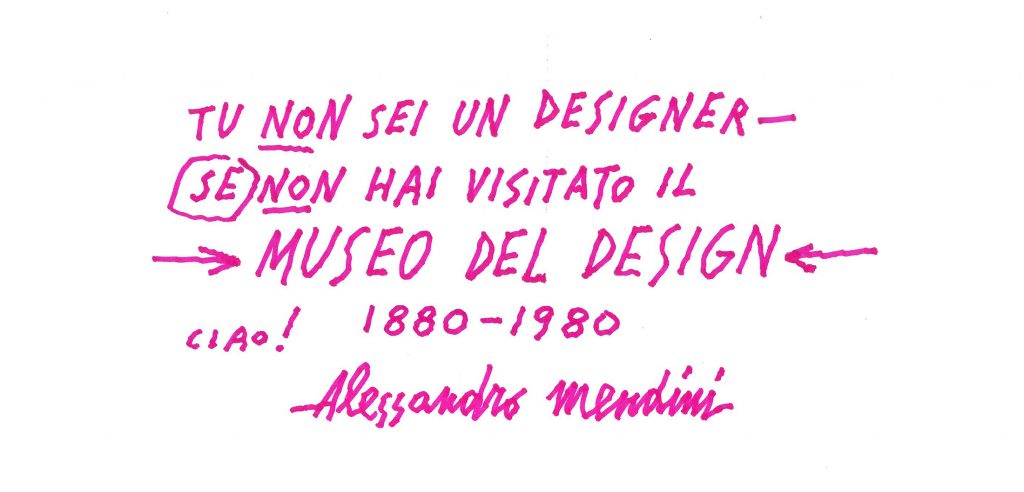History
2021
“DESIGN UTOPIA” Tsinghua Art Museum, Beijing
The exhibition, curated by Alessandro Guerriero and Su Dan, showcases one hundred years of history represented by more than 150 iconic pieces, creations of the major masters of Italian and International Design, on the occasion of the 110th anniversary of Tsinghua University, the one of the most important universities of the People’s Republic of China.
“Design Utopia 1880-1980”, China’s first complete exhibition about the history of international Design, marks a fundamental event, celebrating both the 50th anniversary of diplomatic relations between Italy and China Musei Italiani with the support of the Chinese Minister of Culture, and the 110th anniversary of the Tsinghua University.
2015
“MUSEO DEL DESIGN 1880-1980” Milano Expo 2015 – Borsa Italiana
The collection was rediscovered and moved to Milan by Musei Italiani, maintaining consistency with the original guidelines of the curators and consolidating the institutional arrangement of the collection – formerly part of the Italian design repository network of Triennale Design Museum – through a partnership with Borsa Italiana and thanks to the support of Fondo Aliante / Faram.
The exhibition was presented on the occasion of Expo 2015 at Borsa Italiana’s headquarters “Palazzo Mezzanotte” located in Piazza degli Affari, Milan.
After the success of its preview, the collection has been located in Milan for two years.
1988
THE BIAGETTI – KOENIG COLLECTION
The history begins in Ravenna in 1988, when “Museo dell’Arredo Contemporaneo” was created by Raffaello Biagetti, Giovanni Klaus Koenig, Filippo Alison and Giuseppe Chigiotti, with the aim of representing the most crucial moments of the evolution of Italian and International industrial product design, highlighting nuances and contrasts through the different experiences that have generated contemporary design.
The project was extremely innovative for its time, with the strong intention of taking the visitor on an imaginary voyage through the evolution of creativity applied to objects. The efforts of this core team were strengthened by the help and vision of great names such as Dino Gavina, Ettore Sottsass, Ignazio Gardella and many other authors, who contributed to the creation of a “theatrical museum” where every stage is a scene, a chapter in a book, able to generate a consistent and unbiased vision, chronological and accurate in its references to the most important protagonists of the sector. The original stage project was designed by Piero Castiglioni, who conceived a space all black, a stage where spotlights are focused on objects like actors and each selected piece is placed on a footboard according to Gae Aulenti’s directions.
In the early nineties, Ettore Sottsass and Johanna Grawunder designed the Museum’s entrance pavilion, a building that hosts a mosaic specially realized for the museum. Sottsass is a major character in the Museum’s evolution and he marks the beginning of an uninterrupted comparison with authors and critics such as Ignazio Gardella, Dino Gavina, Lisa Ponti, Gaetano Pesce and Ron Arad.
The collection is a unique didactic instrument which sets out the history of furniture design from 1880 to 1980. The itinerary inside the museum starts from the onset of the Industrial Revolution and continues through a series of chronological islands representing the most important design movements right up to the Poltrona di Proust by Alessandro Mendini, created together with Alessandro Guerriero, founder of Atelier Alchimia.
The names of the designers exhibited are numerous and exceptional: Art Nouveau is represented by the works of Charles Rennie Mackintosh, Antoni Gaudì and Gebrüder Thonet. Then comes the Viennese School of the 1900s with Josef Hoffmann followed by the Bauhaus, Gerrit Thomas Rietveld up to Frank Lloyd Wright. The 1950s are represented by Scandinavian, Italian and American designers such as Alvar Aalto, Charles and Ray Eames, Carlo Mollino, Carlo Scarpa, Luigi Caccia Dominioni and Gio Ponti. The Italy of the 1960s sees the dawn of the industrialization of design and the so-called “Italian Style” of the Castiglioni brothers, Gae Aulenti, Alessandro Mendini and Ettore Sottsass, passing through the most controversial and irreverent forms of expression, typical of Radical Design, to arrive at the shocking works of Memphis and Alchimia.

